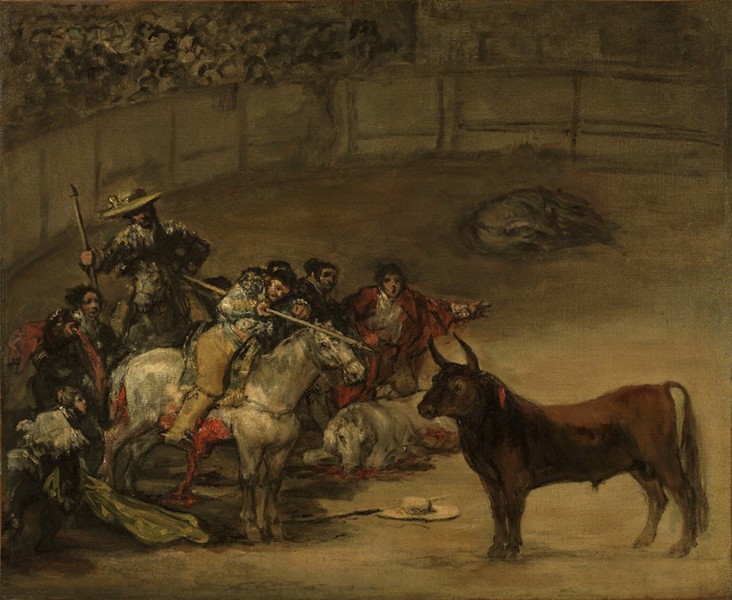- Cronología
- 1824
- Ubicación
- The Paul J. Getty Museum, Los Angeles, United States
- Dimensiones
- 50 x 61 cm
- Técnica y soporte
- Oil on canvas
- Reconocimiento de la autoría de Goya
- Documented work
- Titular
- The J. Paul Getty Museum
- Ficha: realización/revisión
- 03 May 2010 / 15 Jun 2023
- Inventario
- (93.PA.1)
Pintado en Paris en Julio de 1824. / Por / D.n Fran.co Goya. / JMF ("Painted in Paris in July of 1824 / By / Mr Francisco de Goya / JMF". Located on the back of the canvas).
This work was painted during Goya's visit to Paris in July 1824. He stayed in the French capital for three months after leaving Madrid, before moving to Bordeaux. The inscription on the painting referring to his stay was written by Joaquín María Ferrer, as indicated by his initials. It would have been painted at around the same time as the portraits of Ferrer and his wife, Manuela Álvarez Coiñas de Ferrer, and it seems that he was the person who commissioned the work to Goya, with whom he had a friendly relationship.
The work was acquired from Ferrer for the collection of the Marquis of Baroja in Madrid some time before 1900. The painting was then passed by inheritance to the collection of the of the Marchioness of Gándara in Rome. On 9 December 1992 it was put up for auction at Sotheby's of London (lot no. 84), and was acquired by the Getty Museum.
Goya had addressed the theme of bullfighting on various occasions: in the "Caprice" The Bullfight housed in the San Fernando Academy, in the series of small paintings he produced during his convalescence in 1793, and in the series of prints called Bullfighting. In Bordeaux he would revisit to this subject, producing a set of paintings and the series of four lithographs Bulls of Bordeaux.
The scene captures the final moments of the stage of the bullfight known as the "suerte de varas". The background area of the composition is barely sketched in with light, watery brushstrokes which denote the walls of the bullring and the crowd of spectators. The execution of the figures in the foreground - bullfighters and picadores or mounted bullfighters - contrasts with the simple background, since these are depicted with thick, colourful brushstrokes. The group of bullfighters confronts the bull in a moment of great tension: Goya offsets the brutal activity of the men against the passivity of the animal, who is gazing off to one side. The horned beast is standing still, apparently with no intention of attacking anyone, while the picador, mounted on his badly injured horse, tries to provoke him, thrusting his lance at the bull. Another horse lies wounded on the floor, while further away, abandoned on the empty sand of the ring, we can make out the blurred outline of another. Goya has portrayed the animals in this painting as the real victims of the festival which so fascinated the painter.
-
Goya 1900Ministerio de Instrucción Pública and Bellas ArtesMadrid1900consultant editors Aureliano de Beruete, Alejandro Ferrant, Marqués de Pidal and Ricardo Velázquez. May 1900cat. 119
-
GoyaPrado National MuseumMadrid1951July 1951cat. 59
-
Goya: toros y torerosEspace Van GoghArles1990displayed also at Academia de Bellas Artes de San Fernando, Madrid, consultant editor Pierre Gassier.cat. 48
-
Goya. El Capricho y la Invención. Cuadros de gabinete, bocetos y miniaturasMuseo Nacional del PradoMadrid1993from November 18th 1993 to February 15th 1994. Exhibited also at the Royal Academy of Arts, London, March 18th to June 12th 1994 and The Art Institute of Chicago, Chicago, July 16th to October 16th 1994, consultant editors Manuela B. Mena Marqués and Juliet Wilson-Bareaucat. 112
-
Goya. 250 AniversarioMuseo Nacional del PradoMadrid1996consultant editor Juan J. Luna. From March 29th to June 2nd 1996cat. 167
-
Goya’s last WorksThe Frick Art CollectionNew York2006consultant editors Jonathan Brown and Susan Grace Galassi. From February 22nd to May 14th 2006cat. 22
-
L'œuvre peint de Goya. 4 volsParís1928-1950vol. I, p. 295, cat. 274
-
Vie et ouvre de Francisco de GoyaParísOffice du livre1970pp. 356-357, 361, cat. 1672
-
BarcelonaPolígrafa1970vol. I, p. 385, cat. 734
-
L’opera pittorica completa di GoyaMilanRizzoli1974p. 135, cat. 660
-
Francisco de Goya, 4 vols.ZaragozaCaja de Ahorros de Zaragoza, Aragón y Rioja1980-1982vol. IV, p. 210
-
Goya. El capricho y la invención. Cuadros de gabinete, bocetos y miniaturasMadridMuseo del Prado1993pp. 330, 381, cat. 112 y p. 331 (il.)
-
Goya. 250 AniversarioMadridMuseo del Prado1996p. 433, cat. 167 y p. 275 (il.)
-
Goya's last worksNew YorkThe Frick Collection and Yale University Press2006p. 153, cat. 22 y p. 155 (il.)
